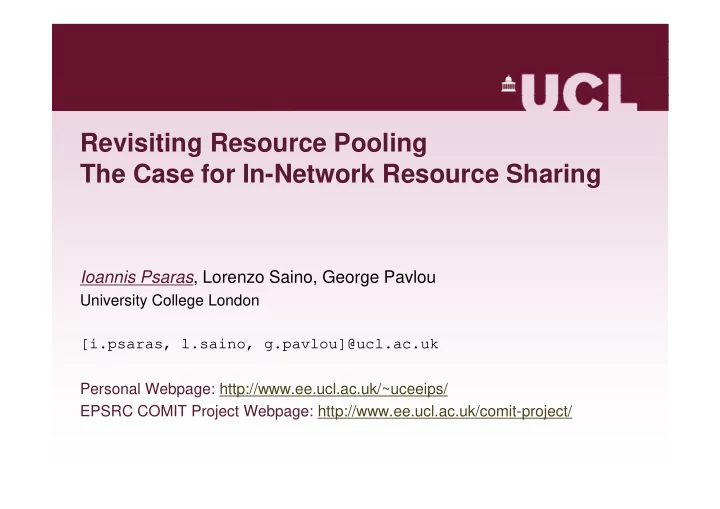

Revisiting Resource Pooling The Case for In-Network Resource Sharing Ioannis Psaras , Lorenzo Saino, George Pavlou University College London [i.psaras, l.saino, g.pavlou]@ucl.ac.uk Personal Webpage: http://www.ee.ucl.ac.uk/~uceeips/ EPSRC COMIT Project Webpage: http://www.ee.ucl.ac.uk/comit-project/
The Resource Pooling Principle “Pooling of customer demands, along with pooling of the resources used to fill those demands” “networked resources behave as a pooled resource” •Pooling can be thought of as a tool to manage uncertainty . •Internet (among others): a network of resources – From bandwidth, computation and storage resources, to information/content and service resources •Uncertainty in the Internet (among others): 1. Senders overloading the network with traffic 2. Excessive demand for bandwidth over some particular link/area Target: Maintain stability and guarantee fairness
Current State of Affairs The Long Long Discussion on TCP • TCP deals with uncertainty using the “one-out one-in” principle • TCP effectively deals with uncertainty by (proactively) suppressing demand! • TCP is moving traffic as fast as the path’s slowest link • End-points have to speculate on the resources available along the e2e path
Vision 1. Push traffic as far in the path and as fast as possible 2. Once in front of the bottleneck, store traffic temporarily in custodian nodes/routers and deal with congestion locally 3. Exploit all available (sub-)paths making decisions on a hop-by-hop manner .
Eliminating Uncertainty Information-Centric Networking (ICN) • We assume a generic ICN environment, where: – Packets (or chunks) are explicitly named – Clients send network-layer requests for named-/addressable- packets (or chunks) – similar to HTTP-GET, but for every packet • Effectively.. – clients (instead of senders) regulate the traffic that is pushed in the network, and – instead of the “data-ACK” model of TCP, in ICN we have a “request-data” model • Result: – Based on requests, each router knows what to expect in terms of traffic.
Eliminating Uncertainty In-Network Caching • Caching has been used for resource optimisation – Reduce delay, save on bandwidth etc. • Overlay Caching: – Put caches in “strategic” places and redirect (HTTP) requests to those caches • In-Network Caching: – Individually named and self-identifiable packets/chunks allow for in- network storage! – Put caches in every router and serve network-layer requests for named chunks from caches on the path • We use in-network caching for temporary storage
Stability & Fairness Global Stability Local Stability Local Fairness Global Fairness
3-Phase Operation • Push-data phase – Open-Loop System – Processor-sharing, RCP-like transmission – Open loop system – senders send even more than what they have received requests for • Push data as far and as quickly as possible • Cache & Detour phase – Every router monitors incoming Requests – When demand is expected to exceed supply, the local router tries to find alternative paths to detour – In the meantime traffic in excess (if any) is cached locally • Backpressure phase – Closed-Loop System – If alternative paths do not exist or are equally congested: • Pace Requests • Send notification upstream to slow down and enter closed-loop transmission
3-Phase Operation • Push-data phase – Open-Loop System – Processor-sharing, RCP-like transmission – Open loop system – senders send even more than what they have received requests for • Push data as far and as quickly as possible D A B C E F
3-Phase Operation • Cache & Detour phase – Every router monitors incoming Requests – When demand is expected to exceed supply, the local router tries to find alternative paths to detour – In the meantime traffic in excess (if any) is cached locally D A B C E F
3-Phase Operation • Backpressure phase – Closed-Loop System – If alternative paths do not exist or are equally congested: • Pace Requests • Send notification upstream to slow down and enter closed-loop transmission D A B C E F
Data on detour availability
Some (very initial) Results
Summary, Open Issues and Things We Don’t (Yet) Know • Information-Centric Networks: – Lots of attention lately – Requires investment and effort – Worth doing, but need to get the full set of advantages • There is an opportunity to deal with congestion control at the network layer • Open Issues: – How do you know detour paths are not congested – How will this co-exist with traditional TCP flows? – Out of order delivery – Flows swapping between original and detour paths
Questions? We are looking for a talented postdoc to join our team @ UCL! Thanks! Ioannis Psaras i.psaras@ucl.ac.uk
Recommend
More recommend